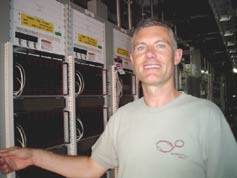
Handy Links
SLAC News Center
SLAC Today
- Subscribe
- Archives: Feb 2006-May 20, 2011
- Archives: May 23, 2011 and later
- Submit Feedback or Story Ideas
- About SLAC Today
SLAC News
Lab News
- Interactions
- Lightsources.org
- ILC NewsLine
- Int'l Science Grid This Week
- Fermilab Today
- Berkeley Lab News
- @brookhaven TODAY
- DOE Pulse
- CERN Courier
- DESY inForm
- US / LHC
SLAC Links
- Emergency
- Safety
- Policy Repository
- Site Entry Form

- Site Maps
- M & O Review
- Computing Status & Calendar
- SLAC Colloquium
- SLACspeak
- SLACspace
- SLAC Logo
- Café Menu
- Flea Market
- Web E-mail
- Marguerite Shuttle
- Discount Commuter Passes
-
Award Reporting Form
- SPIRES
- SciDoc
- Activity Groups
- Library
Stanford
Around the Bay
A New Era for SPEAR3
 SPEAR3 entered a new era on June 14 as engineers flipped the switch on a system designed to deliver rock-solid beam stability by cancelling the effects of outside vibration. Called "Fast Orbit Feedback," this system
has been under development since SPEAR3 was conceived.
SPEAR3 entered a new era on June 14 as engineers flipped the switch on a system designed to deliver rock-solid beam stability by cancelling the effects of outside vibration. Called "Fast Orbit Feedback," this system
has been under development since SPEAR3 was conceived.
The electron beam coursing through the SPEAR3 storage ring is inherently tricky to stabilize as it speeds within the vacuum pipe. This floating ring of electrons, barely thicker than a human hair, is easily perturbed by things like nearby traffic or even weather.
The most disruptive elements to beam stability are the insertion devices—banks of magnets called wigglers and undulators—that are placed along the storage ring and used to excite the electron beam to produce x-rays. Users mechanically open and close these devices to adjust their x-ray beams, causing vibrations and magnetic field changes that disturb the electron beam all around the ring.
Whenever the beam is perturbed, users downstream can experience fluctuations in the precision of the x-rays delivered to their respective beam lines. These fluctuations can lead to fuzzy images or, in extreme cases, unusable data.
Stabilizing the beam by cancelling out external vibrations requires a complex system of beam position monitors and orbit correction magnets. These devices were built into SPEAR3 as a feature conceived during the facility's original design. Initially, beam stability was achieved by collecting data from the beam position monitors every five seconds and then using the magnets to nudge the beam back into position. That meant that perturbations happening within those five seconds could still affect the beam.
Fast orbit feedback improves upon the old system with a network of computer processors that dramatically speed up the beam stabilizing process. Now, using the same beam position monitors, measurements are taken 4,000 times a second, giving the system time to correct the most minute fluctuations.
"This is a big leap forward for our users in terms of beam stability," said Till Straumann who engineered the new system.
The system uses off-the-shelf computer components to provide the processing power. Only about half of the 112 beam position monitors and 108 corrector magnets are currently in use. But even so, the degree of beam stability gained is dramatic, quieting the most subtle fluctuations in beam stability. Future improvements will bring all of these feedback components online with more sophisticated electronics for an even greater degree of stability.
Image: Till Straumann, who engineered the fast orbit feedback system at SSRL, demonstrates the power supplies that control the correction magnets. (Click on image for larger version.)
—Brad Plummer
SLAC Today, June 30, 2006